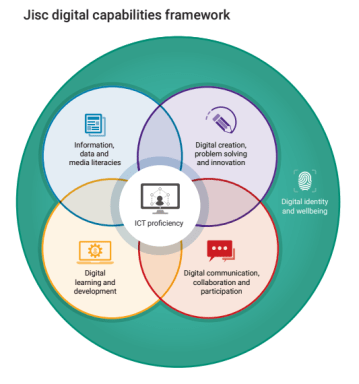Right now in the UK we are focused on climate change. Why? Because we just broke previous temperature records – we hit 40°C– for colleagues in the US, that’s 104°F. I’m not going to debate climate change here; it’s real and if you think it isn’t you’re an idiot, or you’re an idiot and you’re shilling for the oil and gas industry.
Over the last few months I have been pulling resources together for a climate science course, and it’s also given me the opportunity to think about embedding issues around climate science and sustainability into wider contexts. In UK higher education we have been doing this for a while, and there is excellent guidance from AdvanceHE and the QAA providing a framework to help staff in UK higher education institutions incorporate Education for Sustainable Development within their curricula.
Because I work mostly in the digital education space I have been thinking about Carbon Footprints, Sustainability, and Digital Capability. Many people will be aware of the enormous amount of work that Sarah Knight and her team have done around digital capabilities in the HE and FE sector – it’s comprehensive and provides the basis for enabling both staff and students to learn more about their digital behaviours and to develop them to the level they need.

Spaces for most digital skills are represented within the digital capabilities framework diagram. But the framework is missing an awareness of Carbon Footprint and Sustainability.
In 2019 the UK Government published a guide on “How to reduce your digital footprint” as a starting point to understanding the carbon and sustainability issues around use of digital tools, energy use and sourcing of equipment. Because it is a starting point the guide is fairly simplified and lacks nuance. It fails to describe the complex matrix of technology, organisational culture, and individual behaviours. For example it calculates the energy use of an IT system, which may include, video conferencing, but does not offset this with the carbon saving of not commuting. Research from the University of East Anglia showed that during peak lockdown in 2020, Carbon Emissions reduced by 17%, and the majority of those emissions were from “surface transport” – cars and lorries. Clearly that is not a long term solution, and we also need to account for well being. It is neither healthy nor desirable to isolate and reduce our social connections.. But understanding when to travel, and when to video conference could be part of a digital capability, as well as many other aspects, such choices around technology procurement at organisational and individual levels, habits around social media, and video consumption.
The responsibility of achieving sustainability and reducing carbon emissions sits clearly at the Government level. We need a structural response, we need investments in better technology, and better, cleaner energy. That doesn’t absolve us of individual accountability. On a smaller individual scale it may be about behavioural change around, for example, emails; a normal email accounts for 4g of carbon, whereas an email with an average photo uses 50g. We also have to think about whether we need to fly to a meeting or use a conference call, and then if the video is off or on for that call? This should not be about prohibition, but about informed choices and the best outcome for the activity you’re doing. We will only be able to choose best outcomes with a combination of the right information, and proper support that means we can make choices.
I’m still thinking about what digital capability or fluency might look like when we think in terms of carbon footprint and sustainability, and would like to hear from anyone who’s integrated them.
Footnote:

Carbon footprint by diet type per person per year – source https://www.goclimate.com/blog/how-to-reduce-your-carbon-footprint-food/

[…] spent some time over Christmas reflecting on digital education and the post I wrote about digital capabilities and climate back in July, mostly because I was sat in a “bomb cyclone” in New England – another of the […]